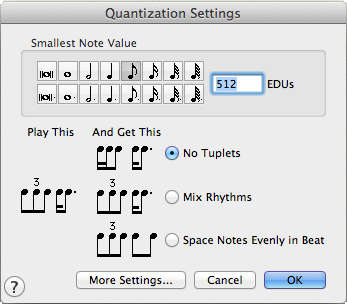We want our music notation software to notate not what we play but what we intend to play. For example, here is a simple melody I played in using Finale’s real-time entry tool, HyperScribe:

I helped Finale notate this example correctly – the first time – by providing some hints as to the rhythmic complexitity of what I was about to play. I did this by choosing a “quantization” setting, which allowed me to specify the smallest note value I wanted Finale to “round-off” to. For this example, my smallest note value was an eight note, so I quantized to an eighth note. This quantization setting is the key to getting Finale to successfully notate what I play.
To set your quantization:
- Select MIDI/AUDIO > Quantization (it’s at the bottom of the menu)
- indicate your desired “smallest note value” and click “OK” (I frequently choose “no tuplets” as well)

With these steps completed you are ready to successfully notate as you play.
For comparison, imagine I set the “smallest note value” to a 128th note. The exact same melody played with 128th quantization might look like this:

That is exactly what I played. This illustrates what I mean when I suggest we want the software to display what we intended, rather than what we played.
What I love most about this second example is that what you see is MUSIC. No matter how I’ve set my quantization, when Finale plays back my performance it includes all the nuance and randomness of my human performance, while displaying the quantized notation. If it played back the earlier eighth note rendition as written, the performance would be machine-like.
By preserving your performance data and displaying quantized notation, Finale embraces your humanity and makes you look – and sound – good!